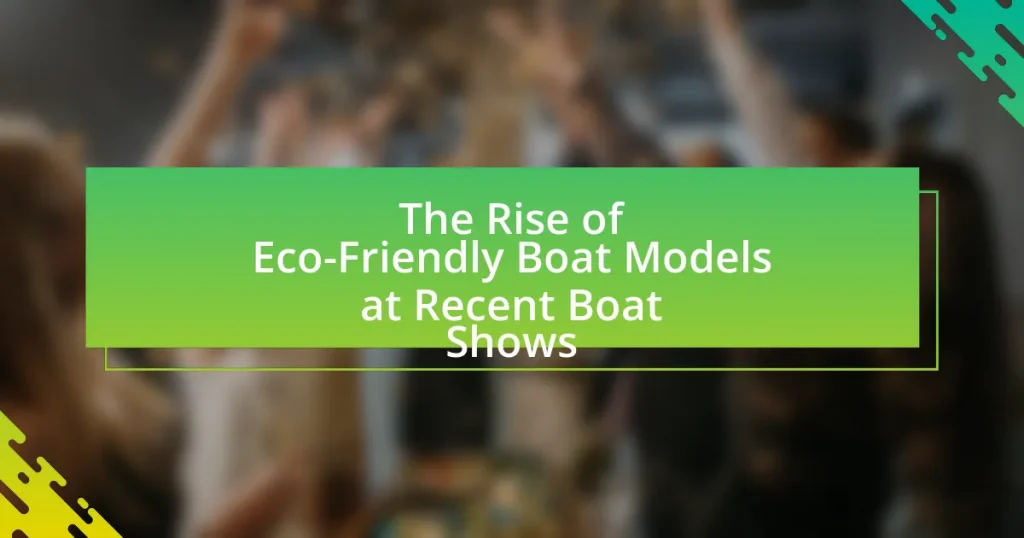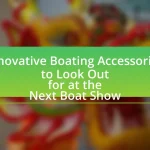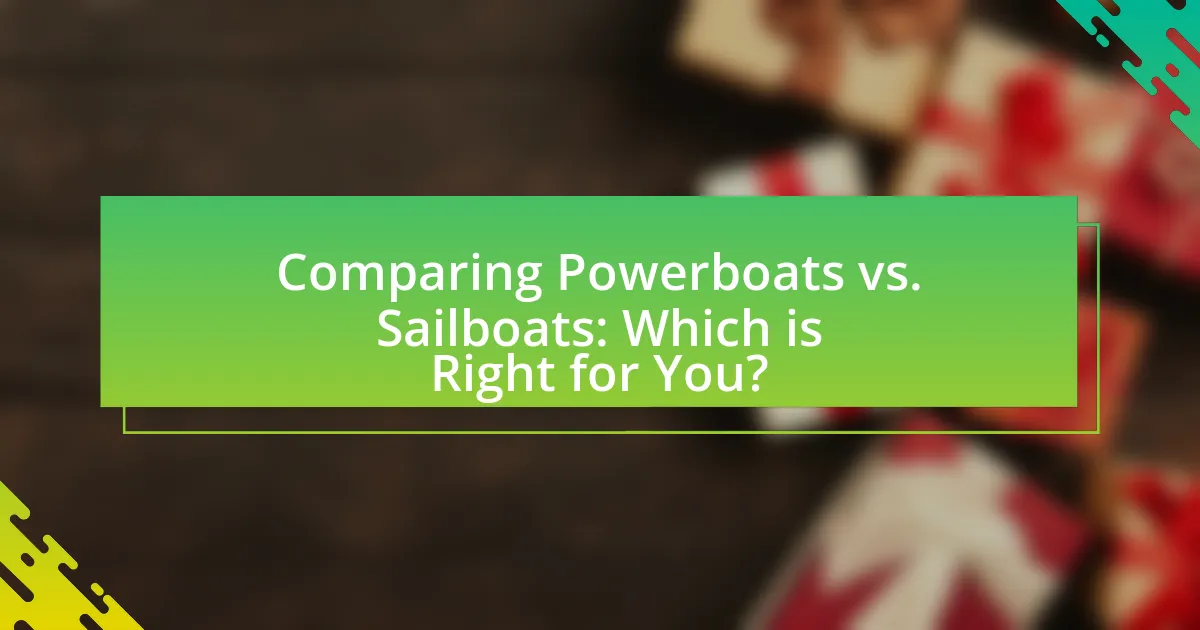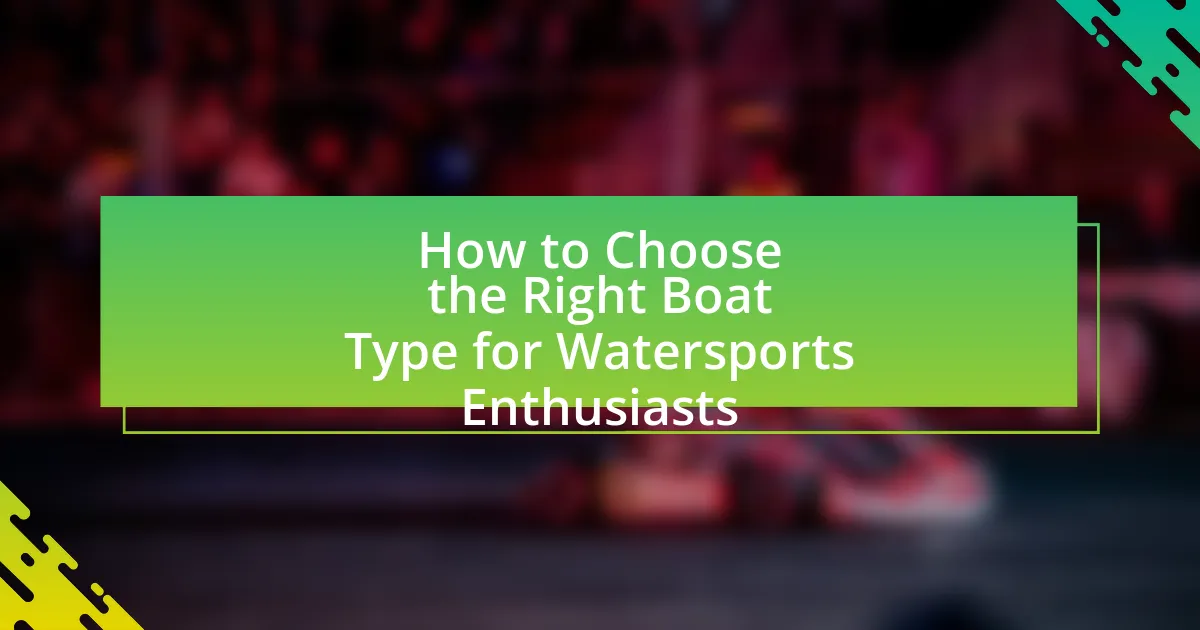Eco-friendly boat models are vessels designed to minimize environmental impact through sustainable materials and energy-efficient technologies. This article explores the differences between eco-friendly and traditional boats, highlighting the use of electric propulsion systems and recycled materials. It discusses the positive effects of these models on marine ecosystems, the growing consumer interest driven by environmental concerns, and the innovative technologies showcased at recent boat shows. Additionally, it examines the challenges manufacturers face in transitioning to sustainable practices and the implications for the boating market, including changing competitive dynamics and future trends. Practical tips for consumers on selecting eco-friendly boats are also provided.
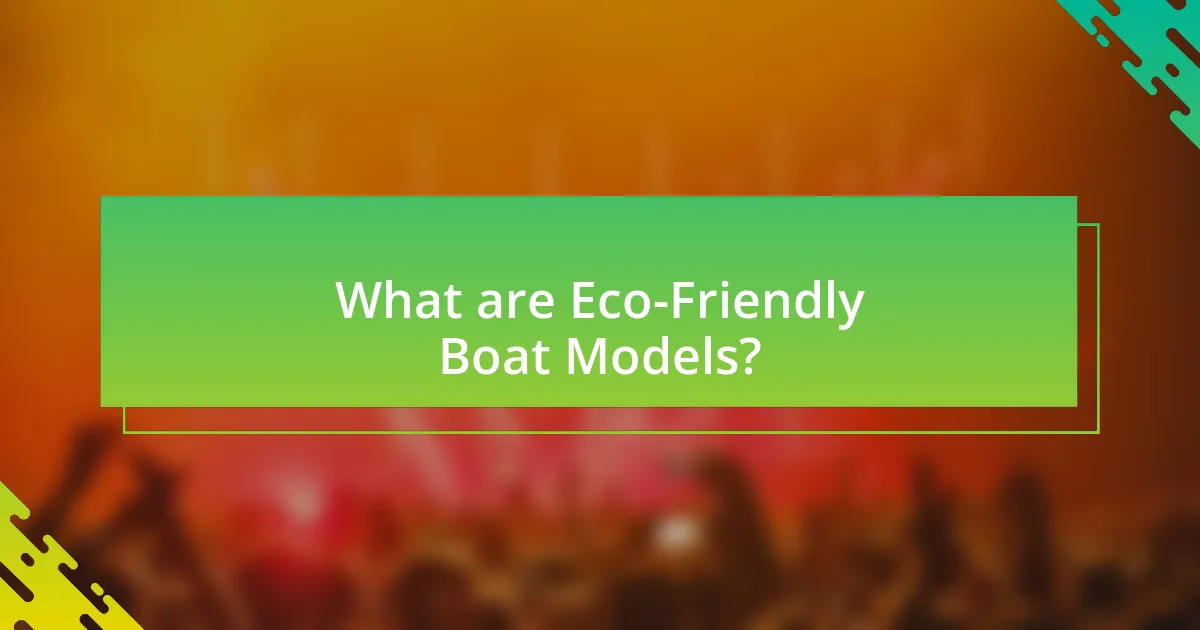
What are Eco-Friendly Boat Models?
Eco-friendly boat models are vessels designed to minimize environmental impact through sustainable materials, energy-efficient technologies, and reduced emissions. These boats often utilize electric or hybrid propulsion systems, which significantly lower greenhouse gas emissions compared to traditional fuel-powered boats. For instance, the use of solar panels and wind turbines on some models allows for renewable energy generation, further enhancing their eco-friendliness. Additionally, manufacturers are increasingly using recycled materials in construction, contributing to a circular economy. The growing popularity of these models is evidenced by their prominent display at recent boat shows, reflecting a shift in consumer demand towards sustainable boating options.
How do Eco-Friendly Boat Models differ from traditional boats?
Eco-friendly boat models differ from traditional boats primarily in their use of sustainable materials and energy-efficient technologies. Traditional boats often rely on fossil fuels for propulsion and are constructed from non-renewable materials, whereas eco-friendly models utilize renewable resources, such as recycled plastics and sustainably sourced wood, and incorporate electric or hybrid propulsion systems. For example, a study by the International Council on Clean Transportation highlights that electric boats can reduce greenhouse gas emissions by up to 90% compared to their gasoline counterparts. This shift not only minimizes environmental impact but also aligns with growing consumer demand for sustainable practices in recreational boating.
What materials are commonly used in Eco-Friendly Boat Models?
Eco-friendly boat models commonly utilize materials such as recycled aluminum, sustainable wood, and biocomposites. Recycled aluminum is favored for its lightweight properties and durability, while sustainable wood, sourced from responsibly managed forests, minimizes environmental impact. Biocomposites, made from natural fibers and resins, offer a renewable alternative to traditional materials. These choices reflect a growing trend in the boating industry towards sustainability and reduced ecological footprints, aligning with consumer demand for environmentally responsible products.
How do Eco-Friendly Boat Models impact marine ecosystems?
Eco-friendly boat models positively impact marine ecosystems by reducing pollution and minimizing habitat disruption. These boats often utilize electric or hybrid propulsion systems, which significantly lower emissions of harmful pollutants such as nitrogen oxides and particulate matter. For instance, a study by the International Council on Clean Transportation found that electric boats can reduce greenhouse gas emissions by up to 90% compared to traditional diesel-powered vessels. Additionally, eco-friendly designs often incorporate materials that are less harmful to marine life, further protecting biodiversity. By decreasing noise pollution and chemical runoff, these boats help maintain healthier aquatic environments, supporting the overall resilience of marine ecosystems.
Why is there a growing interest in Eco-Friendly Boat Models?
There is a growing interest in eco-friendly boat models due to increasing environmental awareness and regulatory pressures. Consumers and manufacturers are recognizing the need to reduce carbon footprints and minimize marine pollution, leading to innovations in sustainable materials and energy-efficient technologies. For instance, the International Maritime Organization has set targets to reduce greenhouse gas emissions from shipping, prompting the marine industry to explore alternative propulsion systems, such as electric and hybrid engines. Additionally, a survey by the National Marine Manufacturers Association indicated that 70% of boat buyers consider environmental impact when making purchasing decisions, highlighting a significant shift towards sustainability in the boating community.
What environmental concerns are driving this trend?
The environmental concerns driving the trend of eco-friendly boat models at recent boat shows include pollution reduction, climate change mitigation, and habitat preservation. These concerns are prompting manufacturers to develop sustainable alternatives that minimize emissions and use renewable energy sources. For instance, the International Maritime Organization reported that shipping contributes approximately 2.5% of global greenhouse gas emissions, highlighting the need for cleaner technologies in the boating industry. Additionally, the increasing awareness of marine ecosystem degradation, such as coral reef destruction and plastic pollution, is pushing consumers and manufacturers alike to prioritize eco-friendly designs and materials.
How do consumer preferences influence the rise of Eco-Friendly Boat Models?
Consumer preferences significantly influence the rise of eco-friendly boat models by driving manufacturers to prioritize sustainability in their designs. As awareness of environmental issues increases, consumers are increasingly seeking boats that minimize ecological impact, leading to a surge in demand for electric propulsion systems and sustainable materials. For instance, a 2022 survey by the National Marine Manufacturers Association indicated that 70% of boat buyers consider environmental impact when making purchasing decisions. This shift in consumer behavior compels manufacturers to innovate and offer eco-friendly options, thereby accelerating the development and availability of such models in the market.
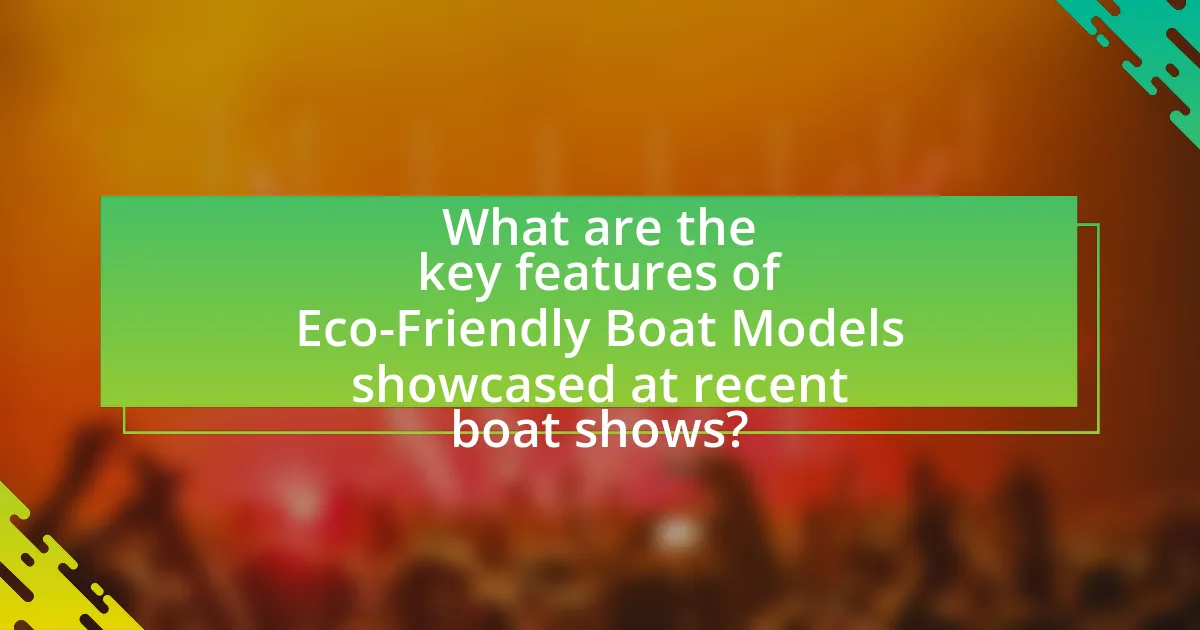
What are the key features of Eco-Friendly Boat Models showcased at recent boat shows?
Eco-friendly boat models showcased at recent boat shows feature advanced electric propulsion systems, sustainable materials, and energy-efficient designs. These boats utilize electric motors powered by renewable energy sources, such as solar panels, significantly reducing carbon emissions. Additionally, manufacturers are increasingly using recycled and biodegradable materials in construction, enhancing sustainability. For instance, some models incorporate hull designs that minimize water resistance, improving fuel efficiency. These innovations reflect a growing commitment to environmental responsibility in the boating industry, aligning with global trends toward sustainability.
What innovative technologies are being presented?
Innovative technologies being presented include electric propulsion systems, solar energy integration, and advanced composite materials. Electric propulsion systems reduce emissions and enhance fuel efficiency, while solar energy integration allows boats to harness renewable energy for onboard power. Advanced composite materials improve durability and reduce weight, contributing to overall energy efficiency. These technologies are crucial in promoting sustainability within the boating industry, aligning with the growing demand for eco-friendly solutions.
How do these technologies enhance sustainability?
Eco-friendly boat technologies enhance sustainability by reducing emissions and minimizing environmental impact. These technologies, such as electric propulsion systems and solar energy integration, significantly lower greenhouse gas emissions compared to traditional fuel-powered boats. For instance, electric boats can reduce carbon emissions by up to 90%, as reported by the International Council on Clean Transportation. Additionally, advancements in materials, like biodegradable composites, decrease waste and promote recycling, further contributing to sustainable practices in the boating industry.
What are the performance benefits of these technologies?
The performance benefits of eco-friendly boat technologies include enhanced fuel efficiency, reduced emissions, and improved operational costs. These technologies, such as electric propulsion systems and hybrid engines, allow boats to operate with lower energy consumption, which can lead to a 30-50% reduction in fuel usage compared to traditional combustion engines. Additionally, the use of renewable energy sources, like solar panels, can further decrease reliance on fossil fuels, resulting in significantly lower greenhouse gas emissions. This shift not only contributes to environmental sustainability but also offers long-term savings on fuel expenses, making eco-friendly boats a financially viable option for consumers.
What design trends are emerging in Eco-Friendly Boat Models?
Emerging design trends in eco-friendly boat models include the use of sustainable materials, energy-efficient propulsion systems, and innovative hull designs that enhance fuel efficiency. Sustainable materials such as recycled plastics and natural fibers are increasingly being utilized in boat construction, reducing environmental impact. Energy-efficient propulsion systems, including electric motors and hybrid technologies, are gaining popularity, as they minimize emissions and reliance on fossil fuels. Additionally, innovative hull designs, such as those inspired by nature, improve hydrodynamics, leading to reduced drag and better fuel efficiency. These trends reflect a growing commitment to sustainability in the boating industry, as evidenced by the increasing number of eco-friendly models showcased at recent boat shows.
How are aesthetics being balanced with eco-friendliness?
Aesthetics are being balanced with eco-friendliness in boat design by integrating sustainable materials and innovative technologies that enhance visual appeal without compromising environmental impact. For instance, manufacturers are using recycled materials, such as reclaimed wood and eco-friendly composites, which not only reduce waste but also offer unique textures and finishes that attract consumers. Additionally, advancements in energy-efficient propulsion systems, like electric motors, allow for sleek designs that minimize emissions while maintaining performance and style. This approach is evident in recent boat shows, where models showcase both aesthetic elegance and eco-conscious features, reflecting a growing consumer demand for sustainable luxury in the boating industry.
What role does user experience play in design choices?
User experience significantly influences design choices by prioritizing user needs and preferences, which leads to more effective and appealing products. In the context of eco-friendly boat models, designers focus on creating intuitive interfaces, comfortable layouts, and sustainable materials that enhance user satisfaction. Research indicates that 88% of online consumers are less likely to return to a site after a bad experience, underscoring the importance of user-centered design in attracting and retaining customers. Thus, integrating user experience into design choices not only improves usability but also aligns with the growing demand for environmentally conscious products in the boating industry.
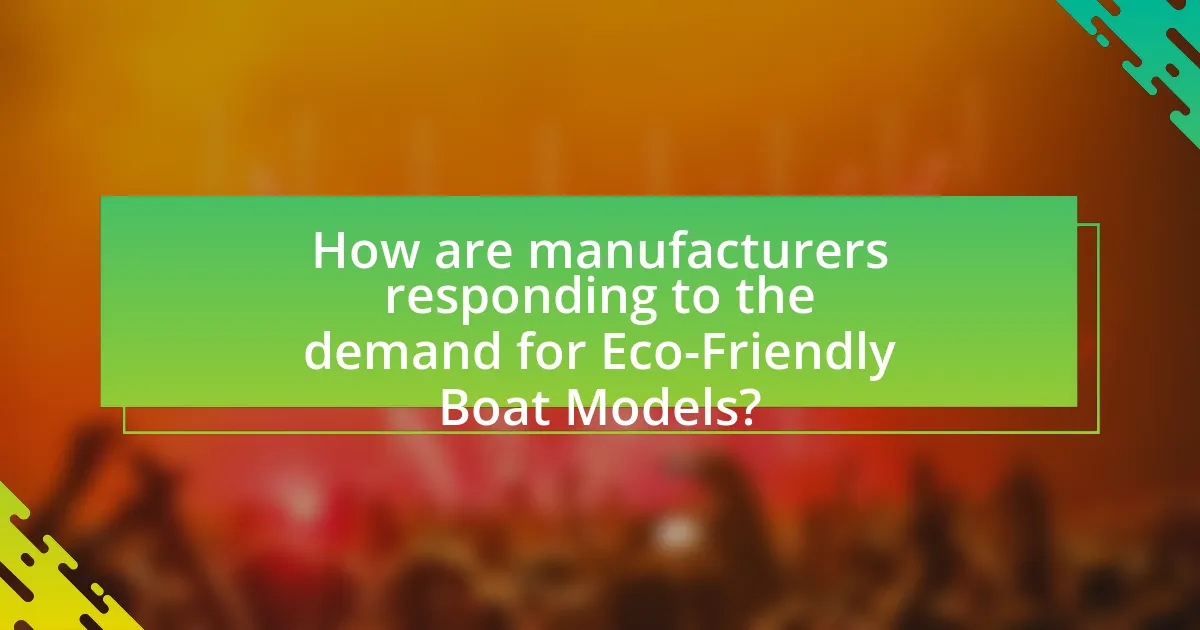
How are manufacturers responding to the demand for Eco-Friendly Boat Models?
Manufacturers are responding to the demand for eco-friendly boat models by increasing the production of electric and hybrid vessels. For instance, companies like Torqeedo and Greenline Yachts have introduced models that utilize electric propulsion systems, significantly reducing emissions and fuel consumption. Additionally, manufacturers are incorporating sustainable materials, such as recycled plastics and eco-friendly composites, into their designs. According to a report by the National Marine Manufacturers Association, the market for electric boats is projected to grow by 20% annually, indicating a strong shift towards environmentally conscious boating solutions.
What strategies are companies employing to innovate?
Companies are employing strategies such as sustainable design, collaboration with technology partners, and consumer engagement to innovate in the eco-friendly boat model sector. Sustainable design focuses on using renewable materials and energy-efficient technologies, which has been shown to reduce environmental impact and appeal to eco-conscious consumers. Collaboration with technology partners allows companies to integrate advanced features like electric propulsion and smart navigation systems, enhancing performance and user experience. Additionally, engaging consumers through feedback and co-creation processes helps companies align their innovations with market demands, as evidenced by the increasing popularity of eco-friendly models showcased at recent boat shows.
How are partnerships influencing the development of Eco-Friendly Boat Models?
Partnerships are significantly influencing the development of eco-friendly boat models by fostering collaboration between manufacturers, technology providers, and environmental organizations. These collaborations enable the sharing of innovative technologies, such as electric propulsion systems and sustainable materials, which enhance the environmental performance of boats. For instance, partnerships between boat manufacturers and battery technology firms have led to advancements in energy storage solutions, resulting in longer-lasting and more efficient electric boats. Additionally, joint ventures with environmental organizations promote sustainable practices and compliance with eco-regulations, ensuring that new models meet stringent environmental standards. This synergy not only accelerates the adoption of eco-friendly technologies but also drives market demand for sustainable boating options, as evidenced by the increasing number of eco-friendly models showcased at recent boat shows.
What challenges do manufacturers face in this transition?
Manufacturers face several challenges in transitioning to eco-friendly boat models, primarily related to cost, technology, and regulatory compliance. The initial investment for developing sustainable materials and technologies can be significantly higher than traditional methods, which may deter manufacturers from making the switch. Additionally, the integration of new technologies, such as electric propulsion systems and renewable energy sources, requires specialized knowledge and expertise that may not be readily available within existing workforces. Furthermore, manufacturers must navigate a complex landscape of regulations and standards aimed at reducing environmental impact, which can vary by region and may require additional resources to ensure compliance. These challenges collectively hinder the pace at which manufacturers can adopt eco-friendly practices in boat production.
What are the market implications of the rise of Eco-Friendly Boat Models?
The rise of eco-friendly boat models significantly impacts the marine market by increasing demand for sustainable products and influencing manufacturers to innovate. As consumer awareness of environmental issues grows, sales of eco-friendly boats, such as electric and hybrid models, have surged, with a reported increase of over 20% in the last three years. This shift compels traditional boat manufacturers to adapt their offerings, invest in green technologies, and potentially face market share losses if they fail to meet evolving consumer preferences. Additionally, regulatory pressures aimed at reducing emissions further drive the transition towards eco-friendly designs, shaping the future landscape of the boating industry.
How is the competitive landscape changing?
The competitive landscape is changing as more boat manufacturers are introducing eco-friendly models in response to increasing consumer demand for sustainable options. This shift is driven by heightened environmental awareness and regulatory pressures aimed at reducing emissions and promoting cleaner technologies. For instance, the International Maritime Organization has set targets to reduce greenhouse gas emissions from shipping, prompting companies to innovate and invest in electric and hybrid propulsion systems. As a result, traditional boat manufacturers are facing competition from new entrants focused solely on sustainable designs, altering market dynamics and consumer preferences.
What future trends can we expect in the eco-friendly boating market?
The eco-friendly boating market is expected to see significant growth driven by advancements in electric propulsion systems, increased use of sustainable materials, and a focus on energy efficiency. Electric boats are projected to dominate the market as battery technology improves, allowing for longer ranges and faster charging times. According to a report by Research and Markets, the electric boat market is anticipated to grow at a CAGR of over 10% from 2021 to 2026. Additionally, manufacturers are increasingly incorporating recycled and biodegradable materials into boat construction, aligning with consumer demand for sustainability. Furthermore, regulatory pressures and incentives for reducing emissions are likely to accelerate the adoption of eco-friendly technologies in boating.
What practical tips can consumers consider when choosing Eco-Friendly Boat Models?
Consumers should prioritize energy efficiency and sustainable materials when choosing eco-friendly boat models. Energy-efficient boats often utilize advanced technologies such as hybrid or electric propulsion systems, which significantly reduce fuel consumption and emissions. Additionally, selecting boats made from sustainable materials, such as recycled aluminum or responsibly sourced wood, contributes to environmental conservation. Research indicates that boats with eco-friendly certifications, like the Clean Marina Program, meet specific environmental standards, ensuring that consumers make responsible choices. Furthermore, consumers should consider the boat’s lifecycle impact, including manufacturing, operation, and disposal, to fully understand its ecological footprint.
